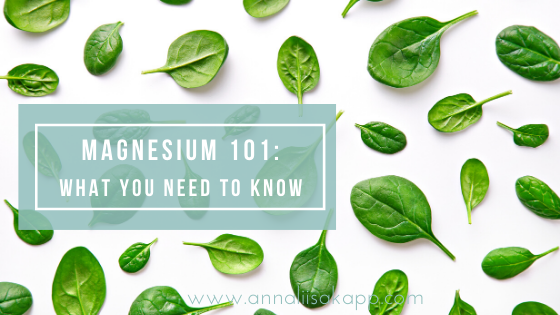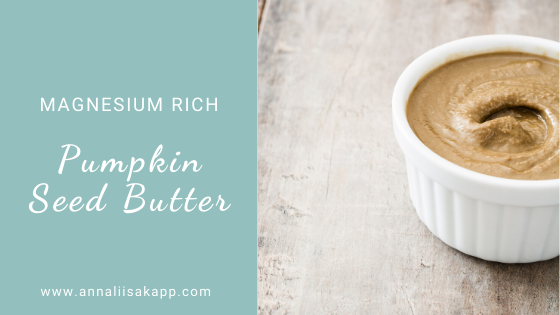
.
Magnesium 101: What You Really Need to Know
Magnesium is one of those nutrients we don’t hear about too much, despite the fact that it’s one of the most abundant minerals in our bodies.
Moreover, it’s the fourth most abundant mineral that we have!
So what role does magnesium play?
Do we really need to be consuming magnesium or taking supplements?
Let’s find out…
- Magnesium helps lower our stress levels. In fact, magnesium is often referred to as the “relaxation mineral.” Serotonin, which is a natural mood stabilizer found mostly in our digestive system, requires magnesium for its production.Magnesium also plays an important role as a nervous system tonic and gets depleted with adrenergic stimulation during acute stress. Therefore, it is recommended that we take magnesium to help manage our stress, anxiety, and mood disorders. In turn, a magnesium deficiency can affect our stress level and emotional state.
- Magnesium is used in over 300 enzymatic functions in the body. Enzymes are important catalysts in the human body and are used in are involved in the production of adenosine triphosphate (ATP) which generates cellular energy.
- Magnesium has also been linked to helping reduce the risk of many diseases, including arthritis, heart disease, and diabetes. Several studies have shown that migraine headaches are associated with low levels of magnesium.
- Magnesium is used in hospitals and given to patients intravenously who are having heart palpitations – the magnesium helps slow down their heart rate.
- Magnesium is necessary for numerous chemical reactions in our body, including making DNA.
- Magnesium helps maintain our brain function by relaying signals between our body and our brain. It prevents overstimulation of nerve cells, which could result in brain damage.
- Magnesium helps regulate muscle contractions – it opposite to calcium to help our muscles relax. Magnesium is commonly recommended for treating muscle cramps, including PMS cramps.
Despite magnesium being so abundant in our body, many people don’t get enough of it.
Some studies say that up to 68% of adults don’t get enough magnesium in accordance with the recommended daily intake (RDI).
So how much magnesium should we be consuming on a daily basis to keep our body functioning as it should?
Adult men should consume 420 mg/day, while adult women should consume 320 mg/day.
There could be consequences from consuming too much magnesium or not enough magnesium:
- Too much magnesium can cause various symptoms, including diarrhea, nausea, vomiting, lethargy, and irregular heartbeat. Therefore, you might not want to take a supplement that contains magnesium if you are already getting enough magnesium through your food and other sources. It’s also important to note that different forms of magnesium can have different benefits and side effects.
- A magnesium deficiency (called hypomagnesemia) could lead to various health conditions, including muscle twitches and cramps, osteoporosis, fatigue, high blood pressure, asthma, heart disease, and diabetes.
Now that we know the importance of magnesium, where do we find magnesium?
Good news! There are plenty of magnesium-rich natural food sources.
- Pumpkin seeds (check out the recipe below for making Creamy Pumpkin Seed Butter)
- Raw almonds and cashews (raw nuts are better than roasted nuts – roasted nuts lose magnesium during the roasting process)
- Dark chocolate
- Black beans, peas, and soybeans
- Green leafy vegetables (spinach)
- Whole grains (oat bran)
- Herbs (coriander, chives, dill, sage)
Supplementing with Magnesium
Several forms of magnesium exist so it is important to recognize the therapeutic applications of each. Minerals such as magnesium or calcium are combined with another molecule to stabilize the compound. Each combination, referred to as a chelate, (such as magnesium citrate) has different absorption, bioavailability and therapeutic value.
Magnesium bis-glycinate is an excellent choice for treating anxiety and depression for the following reasons:
• it is the optimal form for correcting a deficiency due to its superior bioavailability to other forms
• glycine enhances its anxiolytic properties
• it is the optimal form to achieve therapeutic doses without a laxative effect.
Magnesium Citrate might be a good choice for calming the nervous system while helping with constipation. This form of magnesium helps to relax muscles within the intestinal wall, increasing your ability to go to the bathroom. Second, magnesium works as an osmotic, pulling water into the bowels and making stool softer and easier to move.
Magnesium Taurate is a combination of magnesium and the amino acid taurine. Both magnesium and taurine share the ability to improve cardiac function; each has a potentiating effect on insulin sensitivity and also a calming effect on neuromuscular excitability. The actions of both have striking similarities when it comes to cardiovascular health. They both have blood pressure reducing effects, stabilize nerve cells, improve the contraction of the heart muscle and have an anti-thrombotic effect.
Note that magnesium oxide is often used in milk of magnesia products since this form has a strong laxative effect. Even though this combination contains a large proportion of magnesium compared to the oxide molecule, it has poor bioavailability and readily causes loose stools; therefore it is considered the least optimal form to use as a supplement.
Magnesium can also be absorbed through the skin, so consider using a magnesium oil or a bath with bath salts.
But, clearly the easiest (and yummiest) way of getting in your daily magnesium – is to include plenty of food sources high in this multi-tasking mineral, such as creamy pumpkin seed butters!
RECIPE:

Creamy Pumpkin Seed Butter
Ingredients:
2 cups raw pumpkin seeds
1-2 tsp. oil (grapeseed or expeller pressed olive oil)
1/4 tsp Himalayan salt
Preparation:
- Preheat oven to 350 degrees.
- Spread the pumpkin seeds on a baking sheet.
- Bake for 10-12 minutes, until lightly golden.
- Cool for 15-20 minutes.
- Put the pumpkin seeds in a food processor along with salt.
- Run the food processor for approximately 4-5 minutes, until the pumpkin seeds begin to have the texture of butter. If necessary, stop the food processor and scrape the sides.
- Continue running the food processor for another 2-5 minutes until the pumpkin seeds have the texture of butter. Add some of the oil, as needed, until the desired consistency is obtained.
Feeling energized and fabulous starts here!
If you’re tired, feeling like cravings control you, and want simple and natural solutions –
download my free guide to get started.






